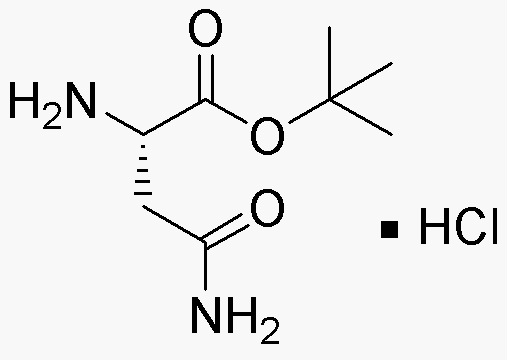L-Asparagine tert-butyl ester hydrochloride is widely utilized in research focused on:
- Peptide Synthesis: This compound serves as a valuable building block in the synthesis of peptides, allowing researchers to create specific sequences for therapeutic applications.
- Drug Development: It plays a role in the development of new pharmaceuticals, particularly those targeting neurological disorders, due to its ability to cross the blood-brain barrier.
- Biotechnology: In the biotechnology sector, it is used in the formulation of culture media for cell growth, enhancing the yield of recombinant proteins.
- Food Industry: The compound can be explored as a flavor enhancer or nutrient supplement, improving the nutritional profile of various food products.
- Research on Amino Acids: It aids in the study of amino acid metabolism and its implications in various metabolic disorders, providing insights for potential treatments.
General Information
Properties
Safety and Regulations
Applications
L-Asparagine tert-butyl ester hydrochloride is widely utilized in research focused on:
- Peptide Synthesis: This compound serves as a valuable building block in the synthesis of peptides, allowing researchers to create specific sequences for therapeutic applications.
- Drug Development: It plays a role in the development of new pharmaceuticals, particularly those targeting neurological disorders, due to its ability to cross the blood-brain barrier.
- Biotechnology: In the biotechnology sector, it is used in the formulation of culture media for cell growth, enhancing the yield of recombinant proteins.
- Food Industry: The compound can be explored as a flavor enhancer or nutrient supplement, improving the nutritional profile of various food products.
- Research on Amino Acids: It aids in the study of amino acid metabolism and its implications in various metabolic disorders, providing insights for potential treatments.
Documents
Safety Data Sheets (SDS)
The SDS provides comprehensive safety information on handling, storage, and disposal of the product.
Product Specification (PS)
The PS provides a comprehensive breakdown of the product’s properties, including chemical composition, physical state, purity, and storage requirements. It also details acceptable quality ranges and the product's intended applications.
Certificates of Analysis (COA)
Search for Certificates of Analysis (COA) by entering the products Lot Number. Lot and Batch Numbers can be found on a product’s label following the words ‘Lot’ or ‘Batch’.
*Catalog Number
*Lot Number
Certificates Of Origin (COO)
This COO confirms the country where the product was manufactured, and also details the materials and components used in it and whether it is derived from natural, synthetic, or other specific sources. This certificate may be required for customs, trade, and regulatory compliance.
*Catalog Number
*Lot Number
Safety Data Sheets (SDS)
The SDS provides comprehensive safety information on handling, storage, and disposal of the product.
DownloadProduct Specification (PS)
The PS provides a comprehensive breakdown of the product’s properties, including chemical composition, physical state, purity, and storage requirements. It also details acceptable quality ranges and the product's intended applications.
DownloadCertificates of Analysis (COA)
Search for Certificates of Analysis (COA) by entering the products Lot Number. Lot and Batch Numbers can be found on a product’s label following the words ‘Lot’ or ‘Batch’.
*Catalog Number
*Lot Number
Certificates Of Origin (COO)
This COO confirms the country where the product was manufactured, and also details the materials and components used in it and whether it is derived from natural, synthetic, or other specific sources. This certificate may be required for customs, trade, and regulatory compliance.


